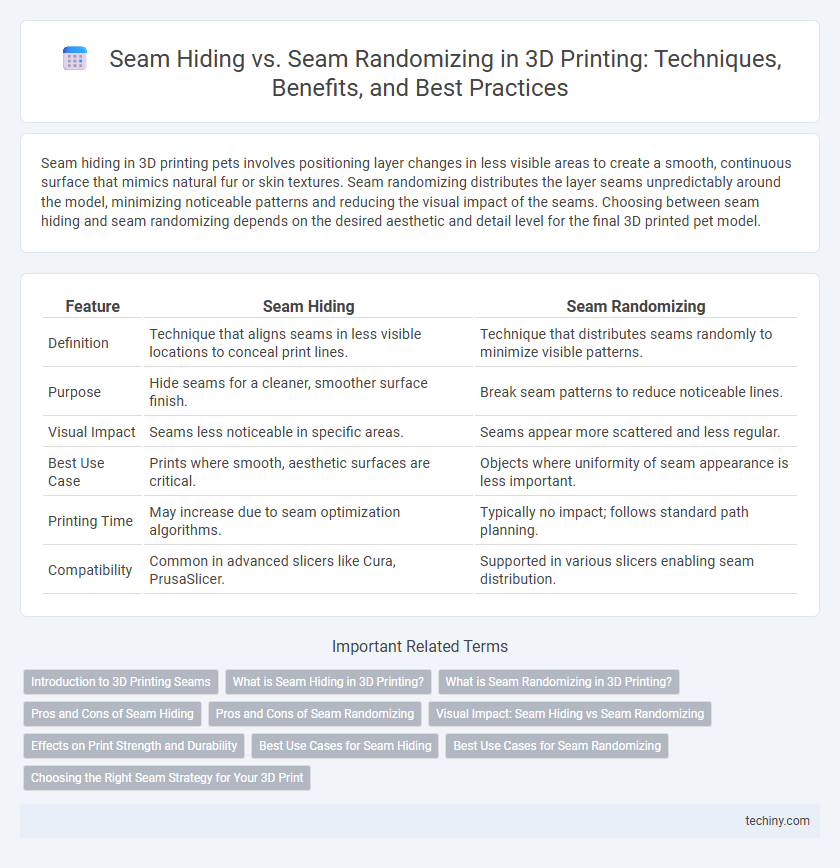Seam hiding in 3D printing pets involves positioning layer changes in less visible areas to create a smooth, continuous surface that mimics natural fur or skin textures. Seam randomizing distributes the layer seams unpredictably around the model, minimizing noticeable patterns and reducing the visual impact of the seams. Choosing between seam hiding and seam randomizing depends on the desired aesthetic and detail level for the final 3D printed pet model.
Table of Comparison
| Feature | Seam Hiding | Seam Randomizing |
|---|---|---|
| Definition | Technique that aligns seams in less visible locations to conceal print lines. | Technique that distributes seams randomly to minimize visible patterns. |
| Purpose | Hide seams for a cleaner, smoother surface finish. | Break seam patterns to reduce noticeable lines. |
| Visual Impact | Seams less noticeable in specific areas. | Seams appear more scattered and less regular. |
| Best Use Case | Prints where smooth, aesthetic surfaces are critical. | Objects where uniformity of seam appearance is less important. |
| Printing Time | May increase due to seam optimization algorithms. | Typically no impact; follows standard path planning. |
| Compatibility | Common in advanced slicers like Cura, PrusaSlicer. | Supported in various slicers enabling seam distribution. |
Introduction to 3D Printing Seams
Seams in 3D printing are the visible lines where each layer starts and ends, affecting surface quality and aesthetics. Seam hiding techniques align these lines in less visible areas or use printer settings to minimize their prominence. Seam randomizing distributes start points across the model to reduce pattern visibility, balancing appearance with printing consistency.
What is Seam Hiding in 3D Printing?
Seam hiding in 3D printing refers to the technique of positioning layer start and end points strategically to minimize visible lines or marks on the printed object's surface. This method targets reducing surface imperfections by aligning seams with less noticeable areas or textured features, improving overall print aesthetics. Effective seam hiding enhances print quality by concealing layer transitions, especially on curved or complex geometries.
What is Seam Randomizing in 3D Printing?
Seam randomizing in 3D printing is a technique that distributes the layer change seams randomly around the print instead of aligning them in one spot, reducing visible flaws. This method improves surface aesthetics by preventing the formation of a single prominent seam, which is especially beneficial for cylindrical or curved objects. Seam randomizing optimizes print quality by breaking up patterns that can draw attention to seam lines, enhancing the overall finish without requiring additional post-processing.
Pros and Cons of Seam Hiding
Seam hiding in 3D printing creates a consistent, less noticeable line by aligning layer transitions, which improves surface aesthetics on curved or detailed parts. However, this technique can result in visible ridges or blobs at the seam location, potentially compromising overall print smoothness. While seam hiding simplifies post-processing in some cases, it may require careful calibration to minimize imperfections and maintain structural integrity.
Pros and Cons of Seam Randomizing
Seam randomizing in 3D printing distributes layer start points unevenly, reducing visible seam lines on the final object and enhancing overall surface aesthetics. This technique can increase print time slightly and may introduce minor imperfections due to variable seam placement, impacting highly detailed or smooth-surface prints. However, it is ideal for objects where uniform seam positioning is undesirable, offering a balanced approach between seam visibility and print consistency.
Visual Impact: Seam Hiding vs Seam Randomizing
Seam hiding in 3D printing minimizes visible lines by strategically positioning layer transitions in less noticeable areas, enhancing overall print aesthetics. Seam randomizing disperses layer changes across different points to avoid repetitive seam patterns, reducing the visual prominence of imperfections. Both techniques improve the final surface quality, but seam hiding delivers a cleaner look while seam randomizing excels in masking repetitive defects on curved or detailed models.
Effects on Print Strength and Durability
Seam hiding techniques in 3D printing improve cosmetic appearance by aligning layer start points but can create stress concentrations that reduce print strength and durability. Seam randomizing distributes these start points across the model, minimizing stress buildup and enhancing overall structural integrity. Optimizing seam strategy directly influences the mechanical performance and longevity of printed parts.
Best Use Cases for Seam Hiding
Seam hiding in 3D printing is best suited for models requiring smooth, continuous surfaces such as figurines, display pieces, and functional parts where visible layer transitions could compromise aesthetics or performance. This technique strategically positions seams in low-visibility areas to enhance the final print's visual quality without altering structural integrity. Seam hiding excels in projects demanding a polished finish, helping to reduce post-processing time and maintain clean surface contours.
Best Use Cases for Seam Randomizing
Seam randomizing in 3D printing excels for models with complex geometries or organic shapes, where unpredictable seam placement reduces visible artifacts. Ideal for multi-color or multi-material prints, it diffuses seam visibility by spreading imperfections across varied locations. This technique enhances aesthetic quality in figurines, cosplay props, and detailed prototypes by minimizing repetitive seam lines that can distract from intricate surfaces.
Choosing the Right Seam Strategy for Your 3D Print
Choosing the right seam strategy for your 3D print significantly impacts surface finish and mechanical strength. Seam hiding positions layer starts in less visible areas or corners to minimize visual defects, enhancing aesthetic quality. Seam randomizing distributes seams sporadically across the print surface, reducing noticeable seam lines but potentially affecting uniform texture and structural consistency.
Seam Hiding vs Seam Randomizing Infographic

 techiny.com
techiny.com